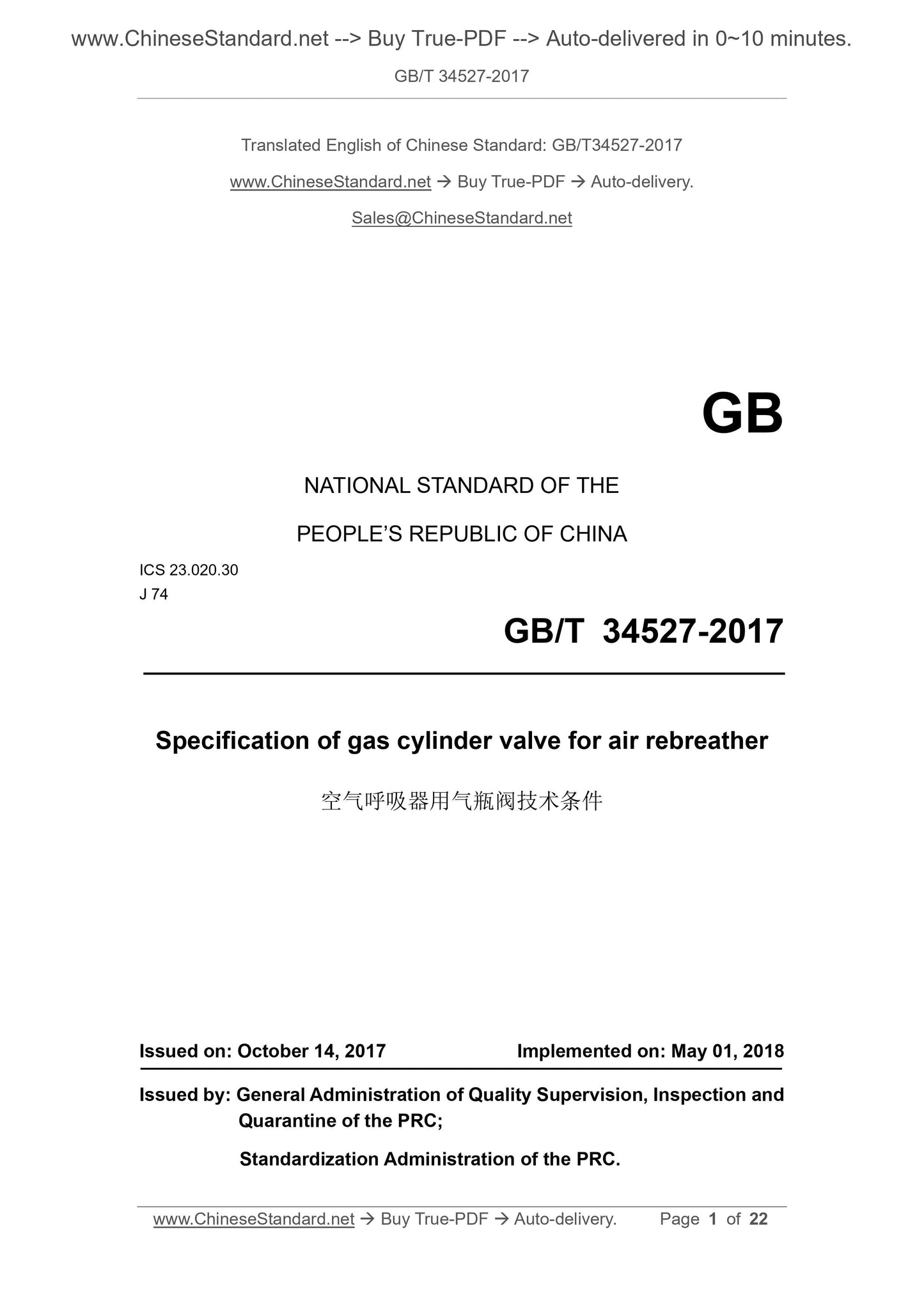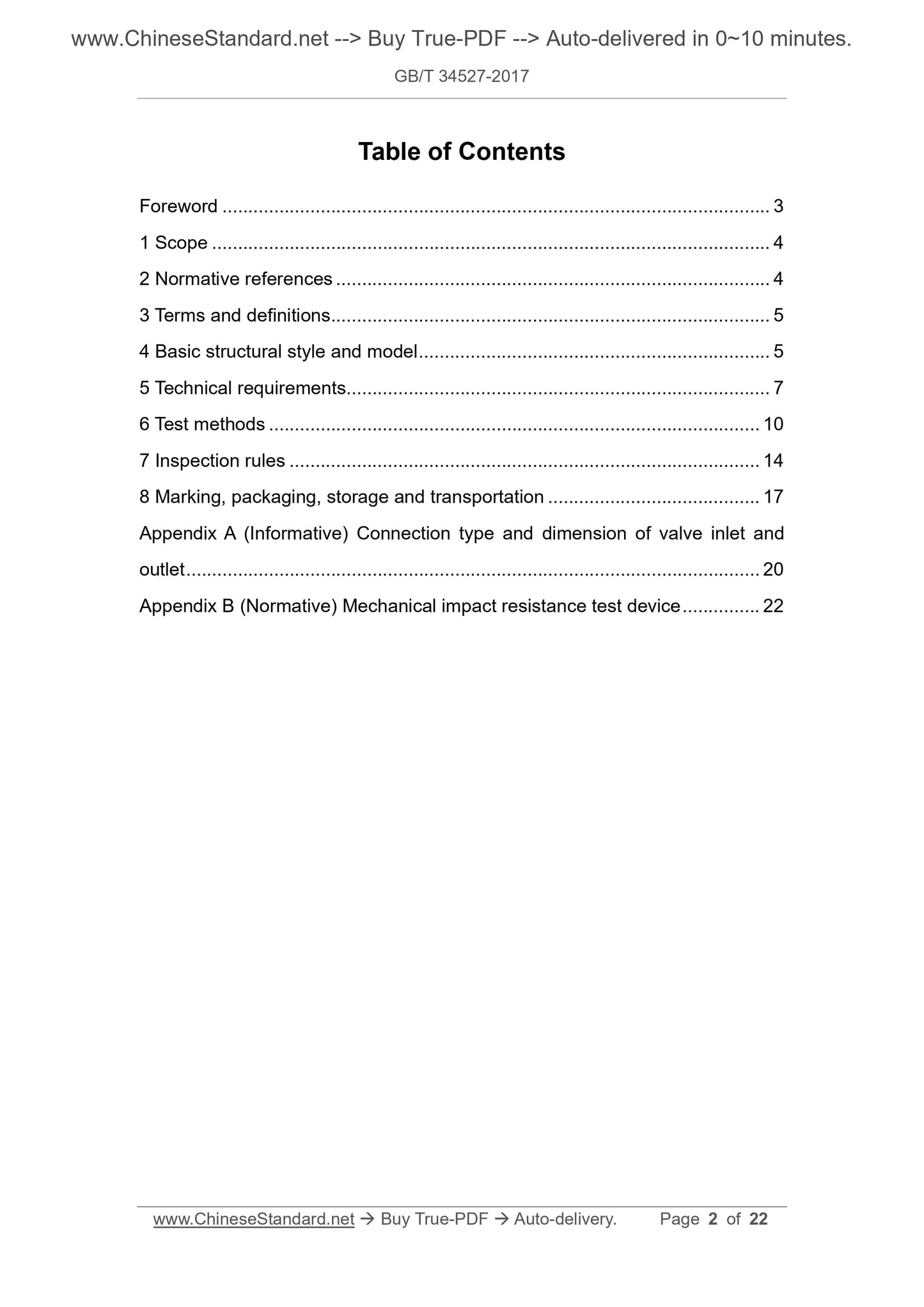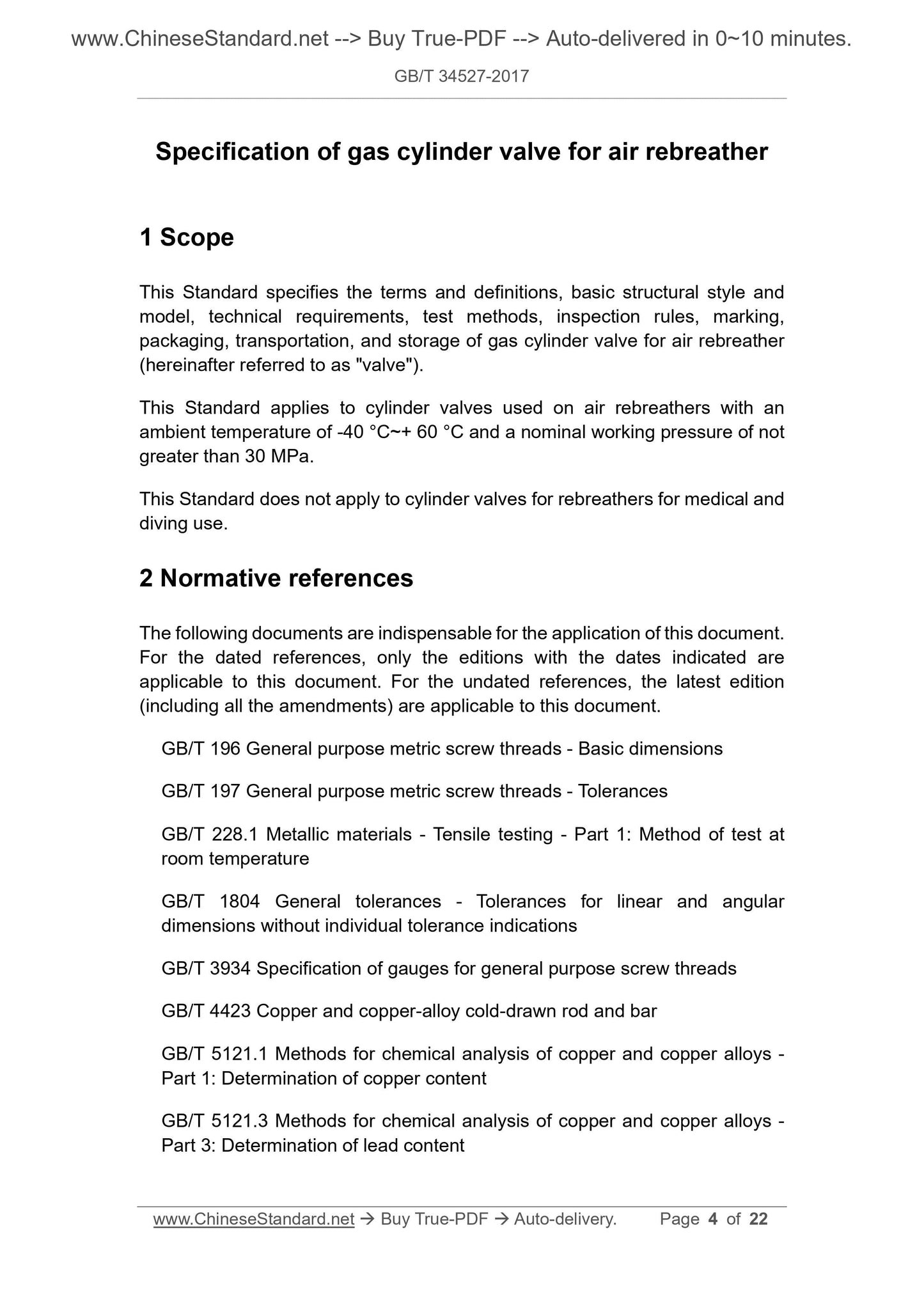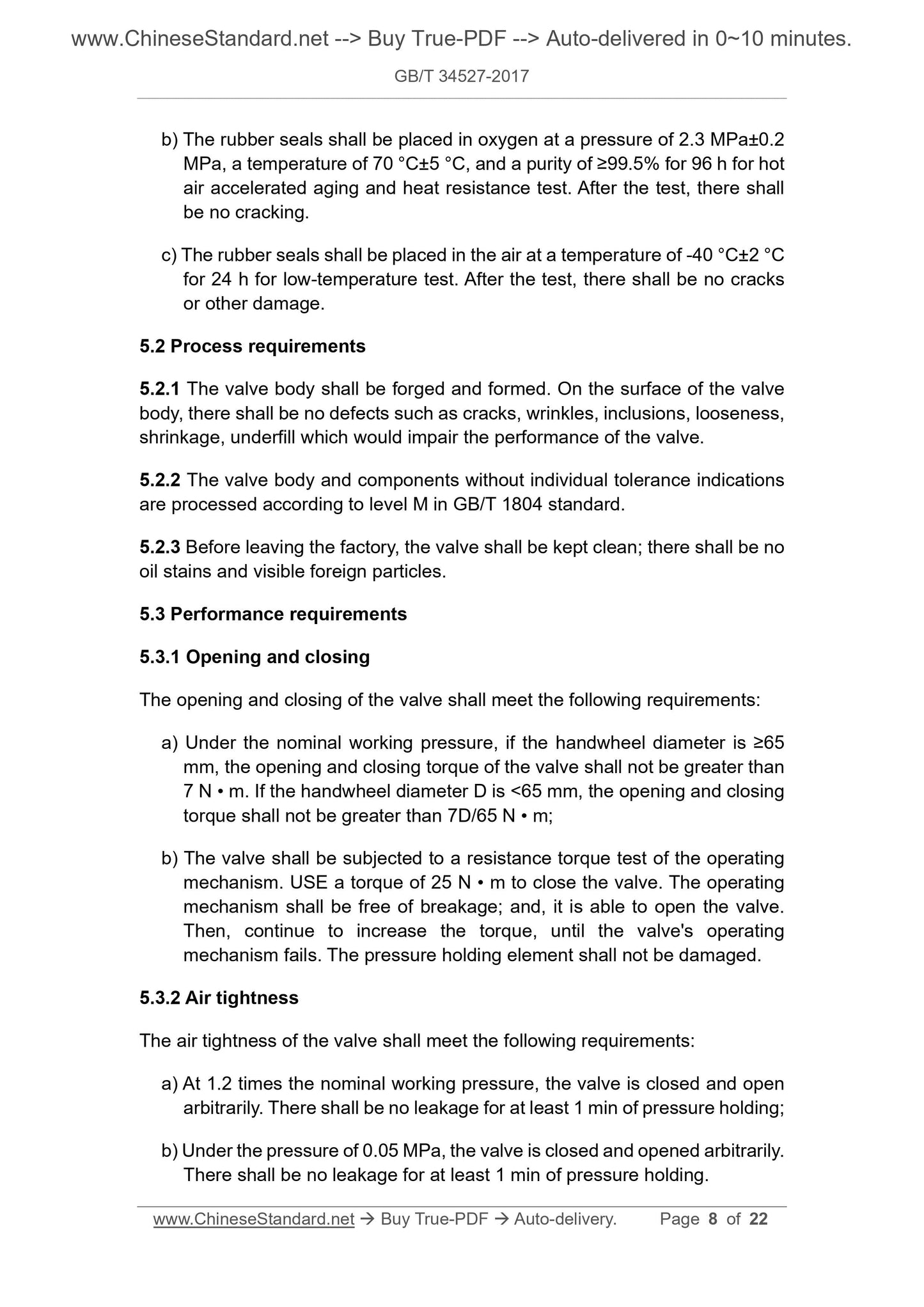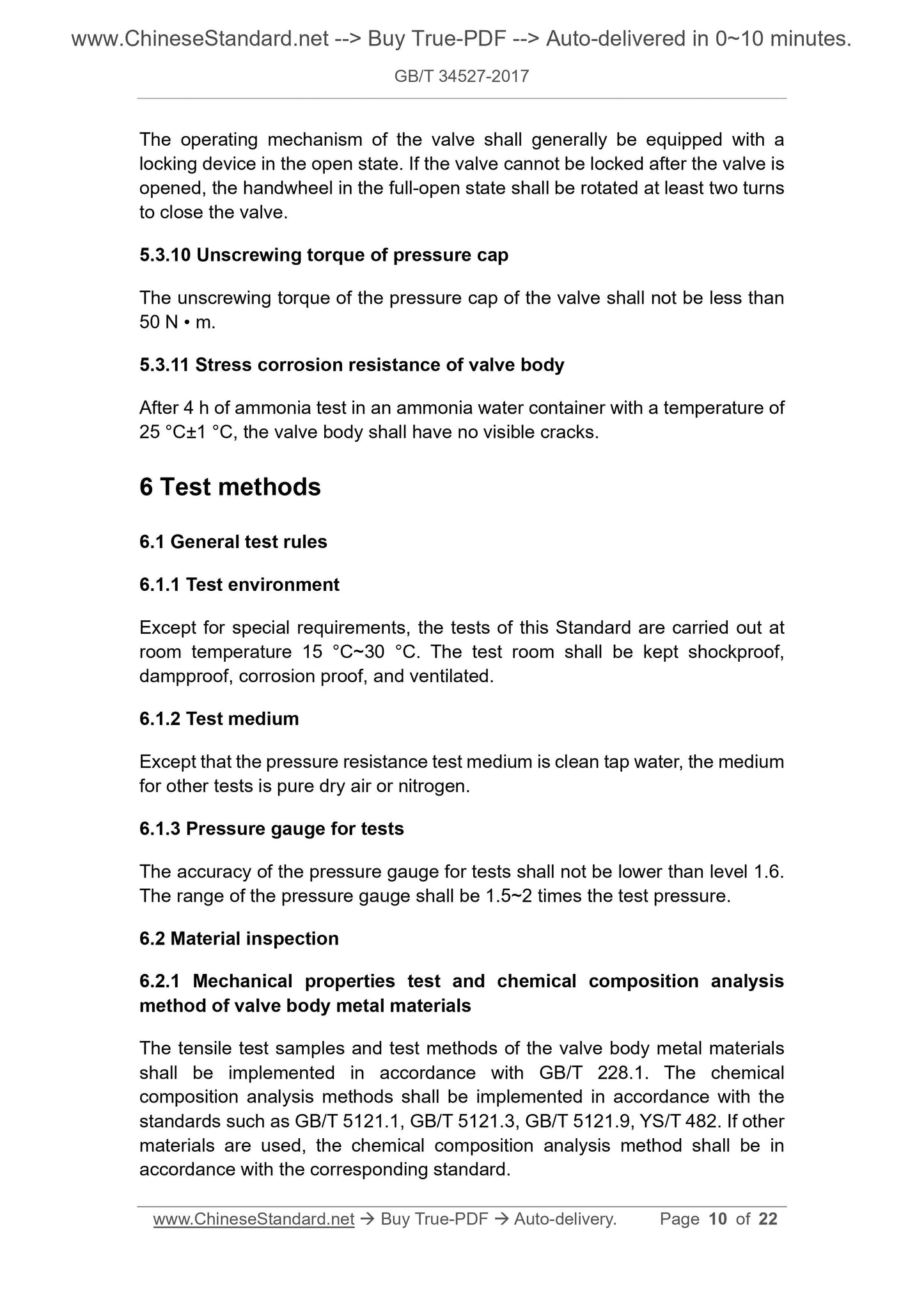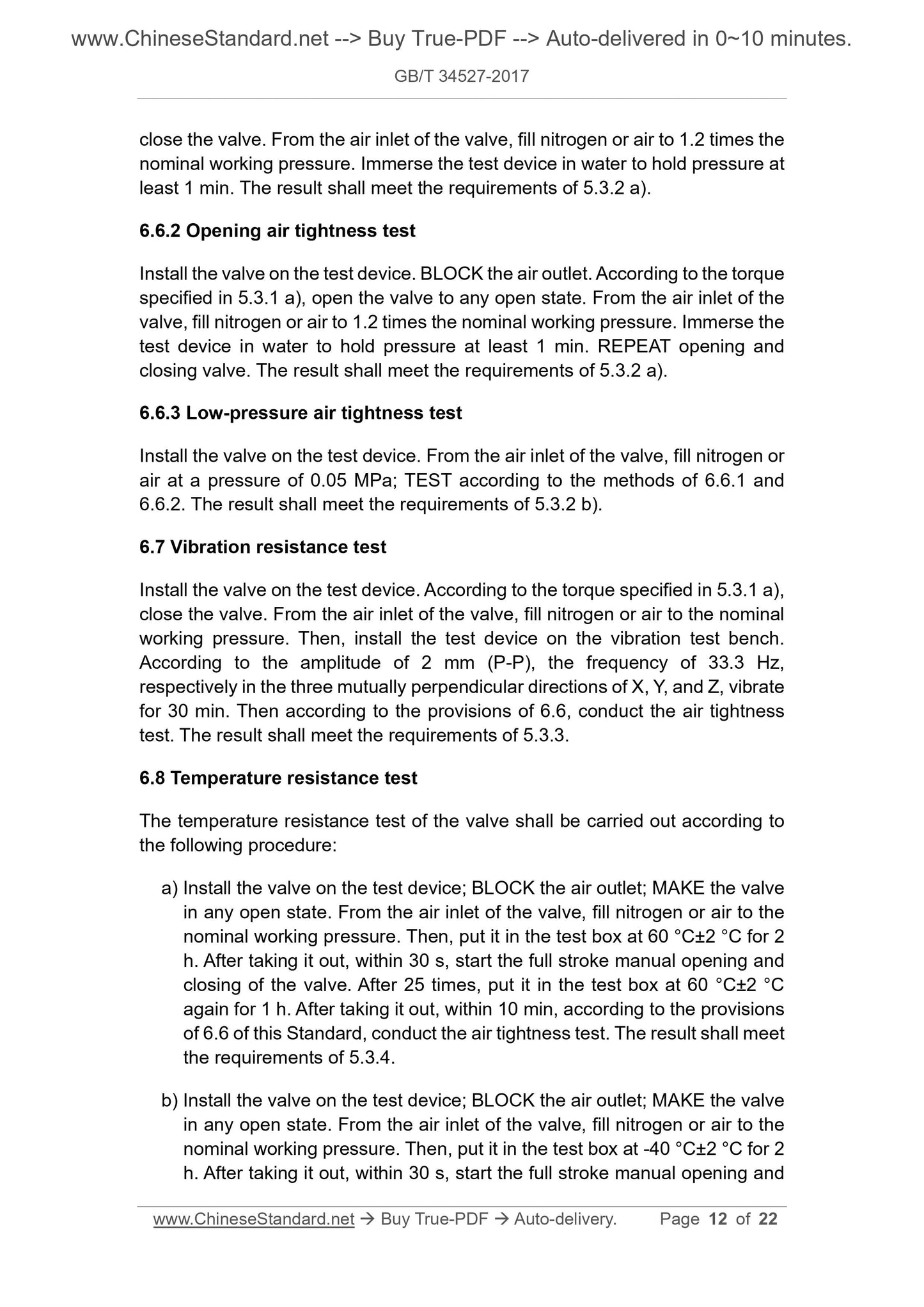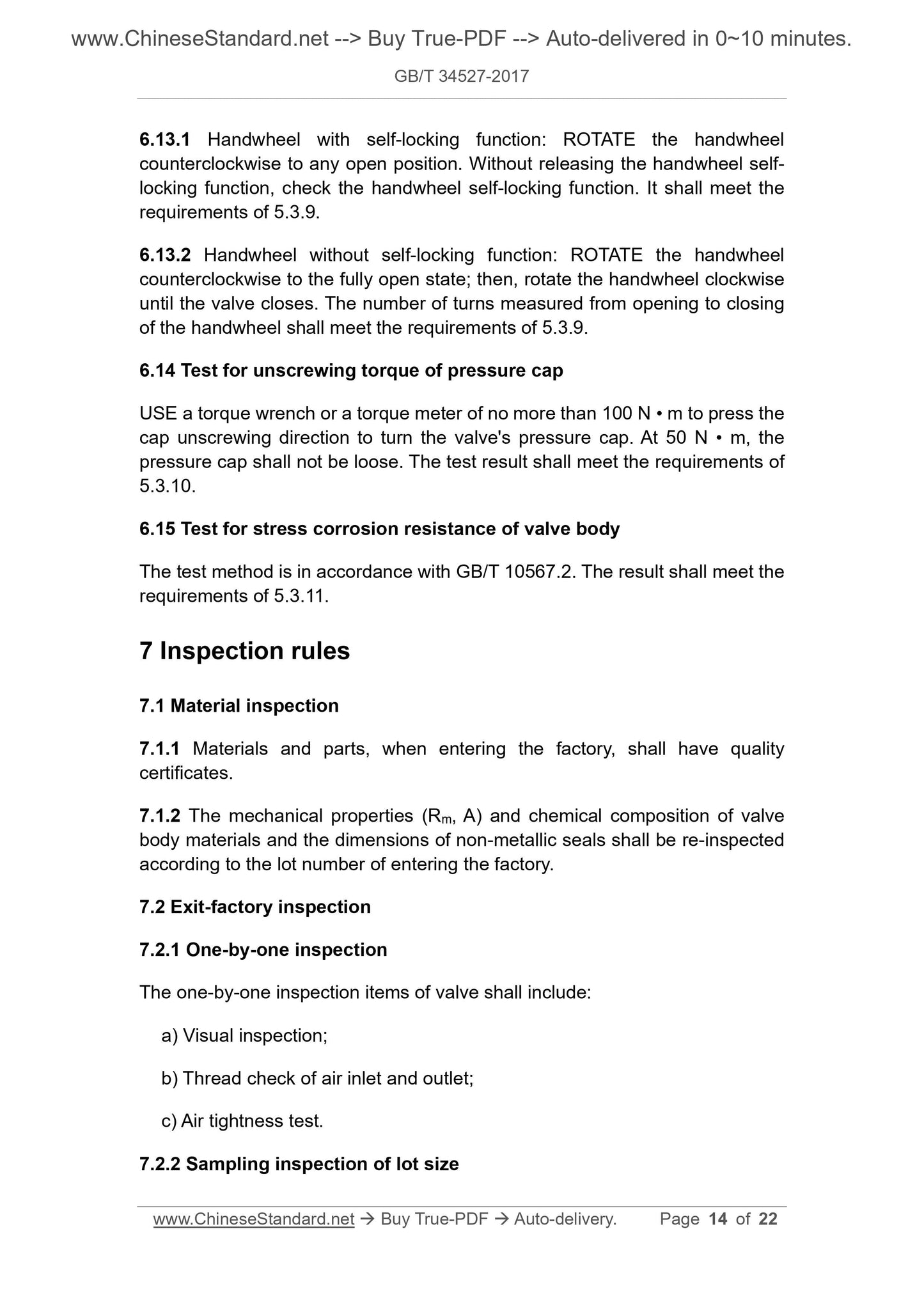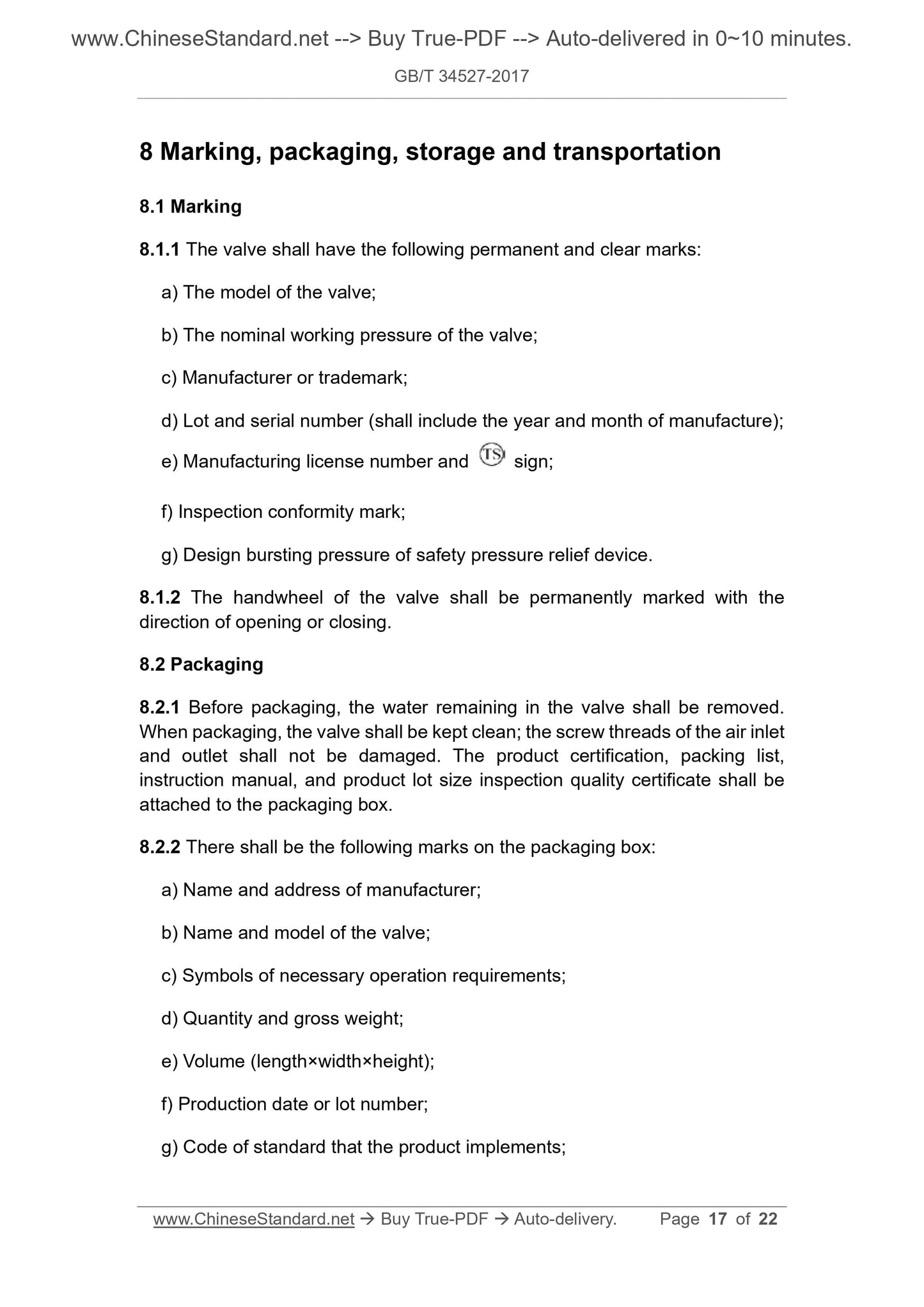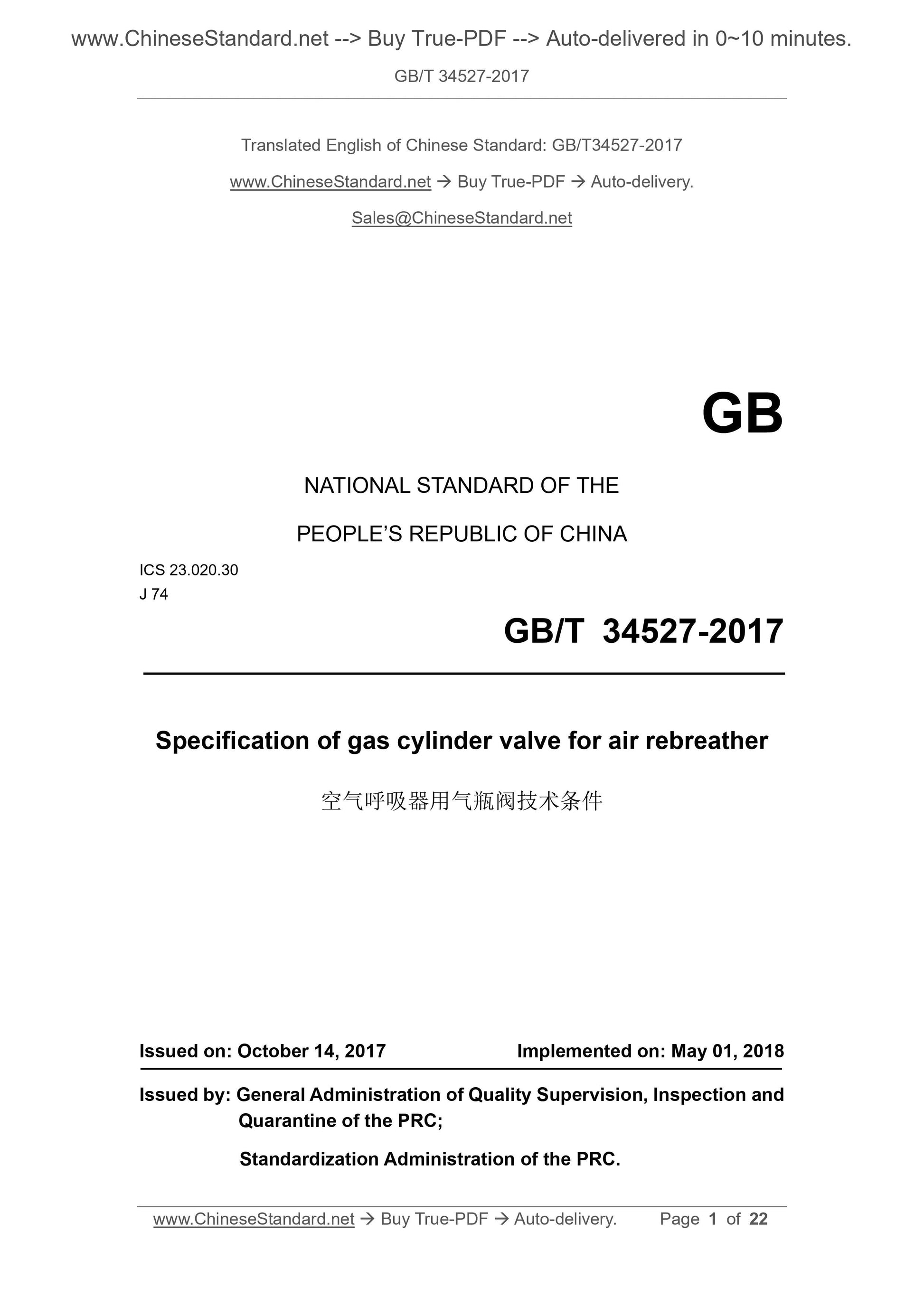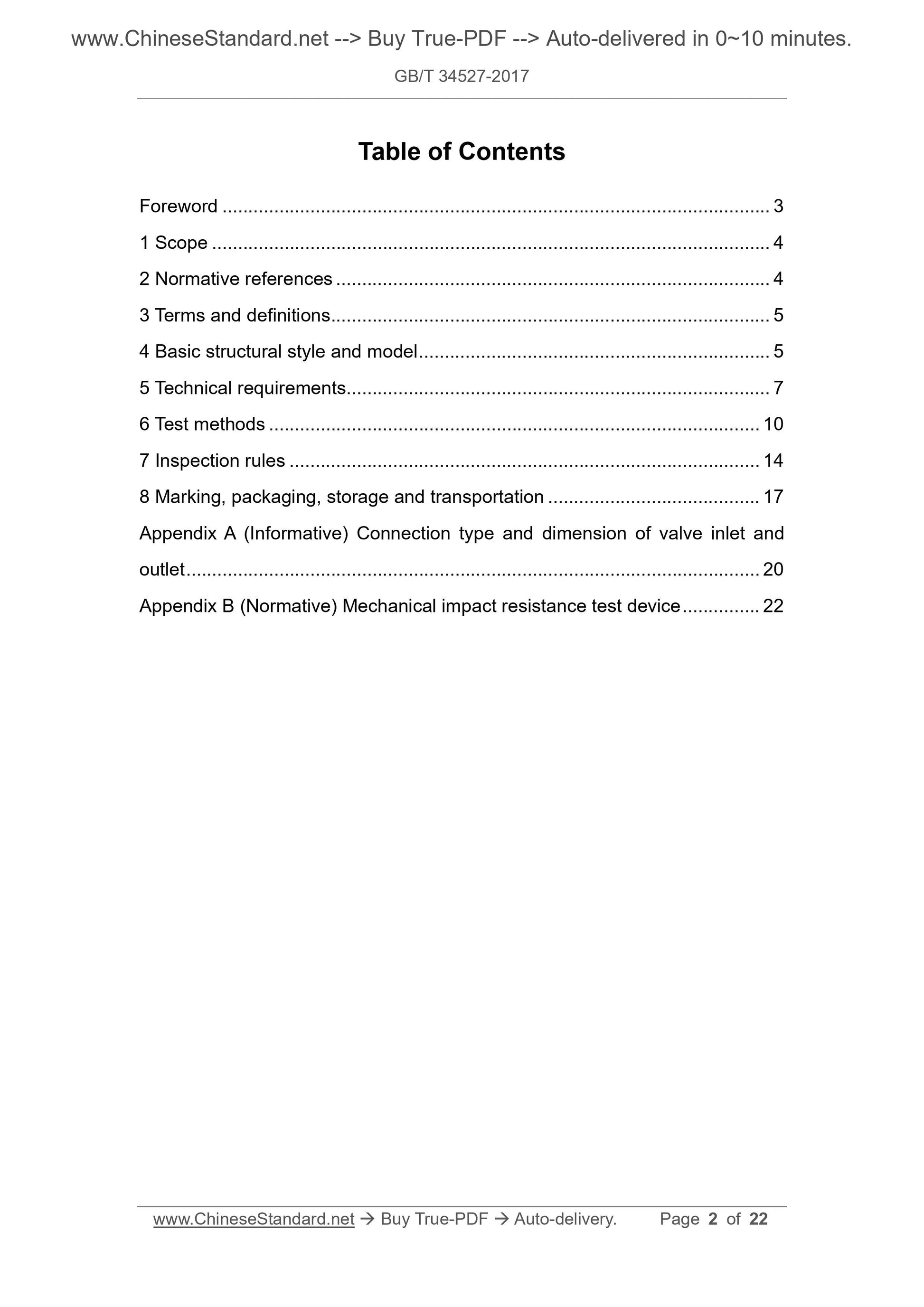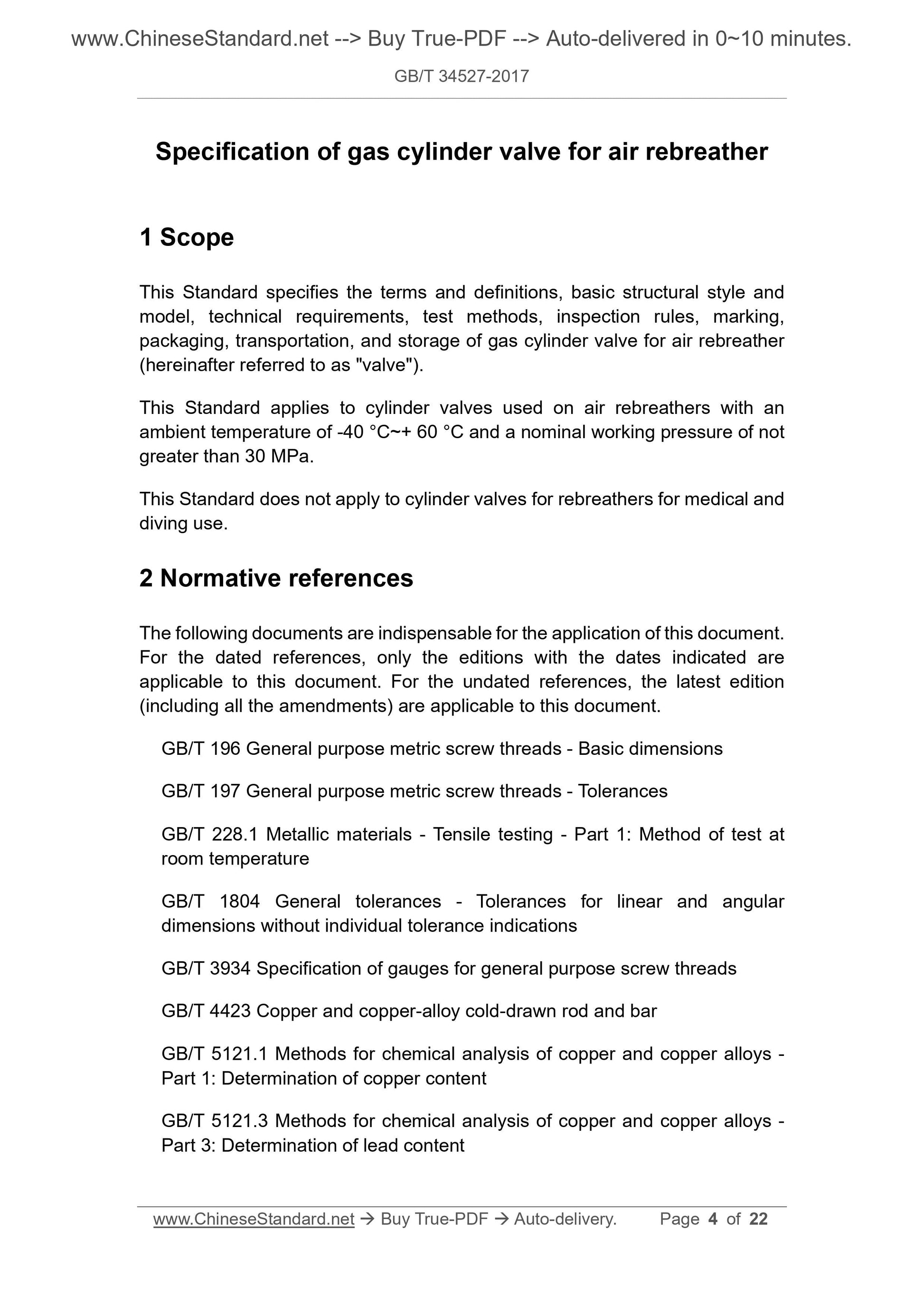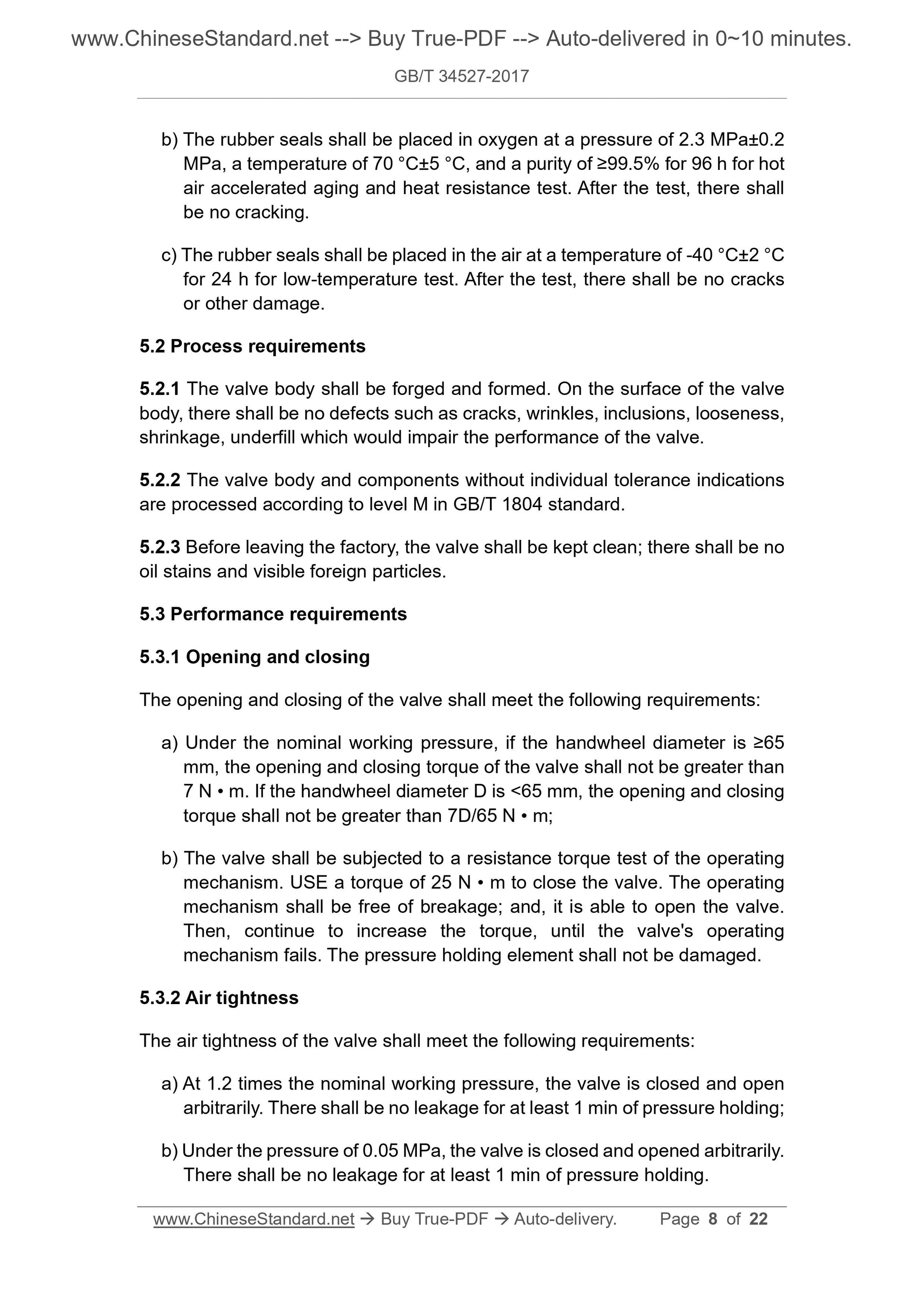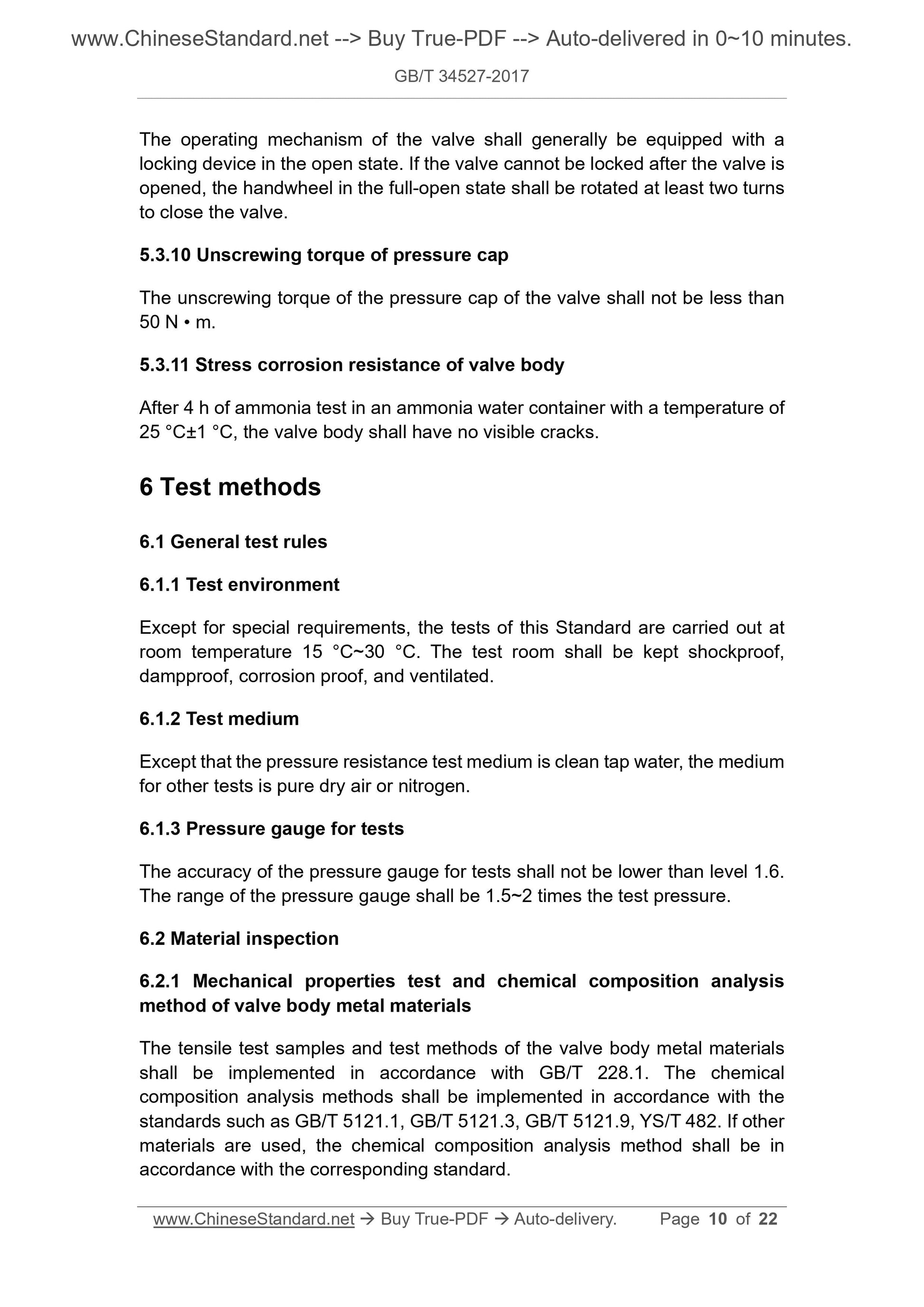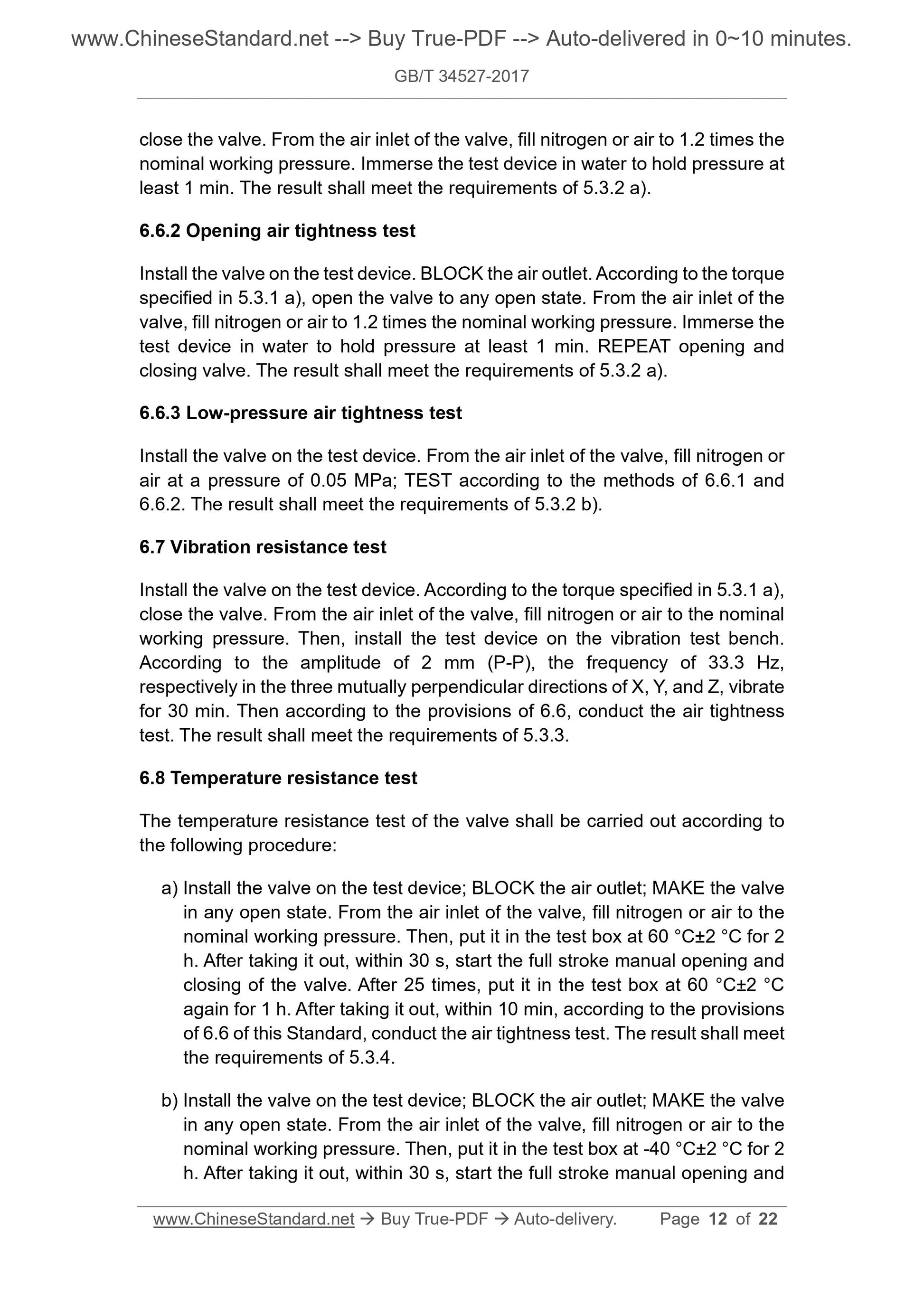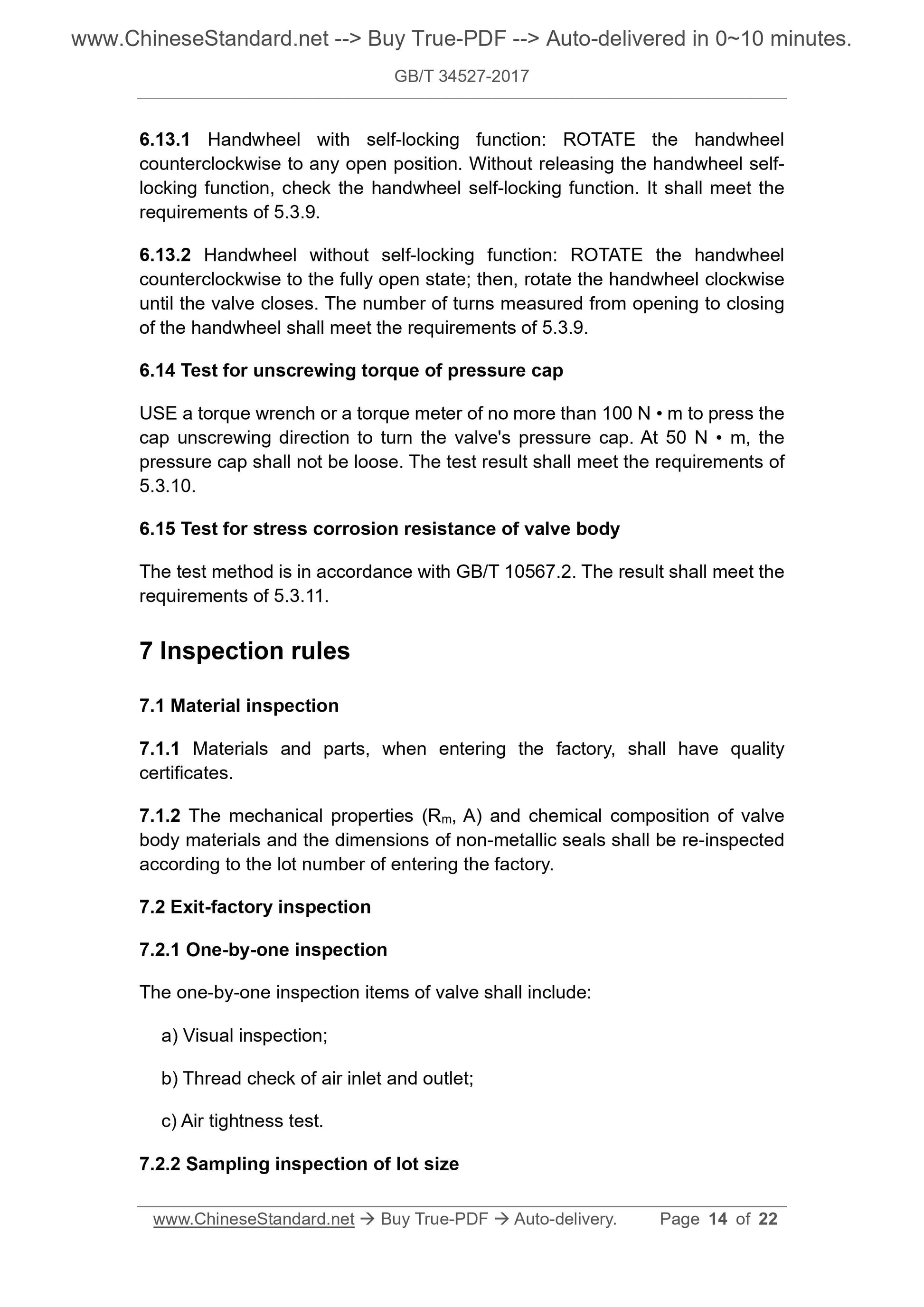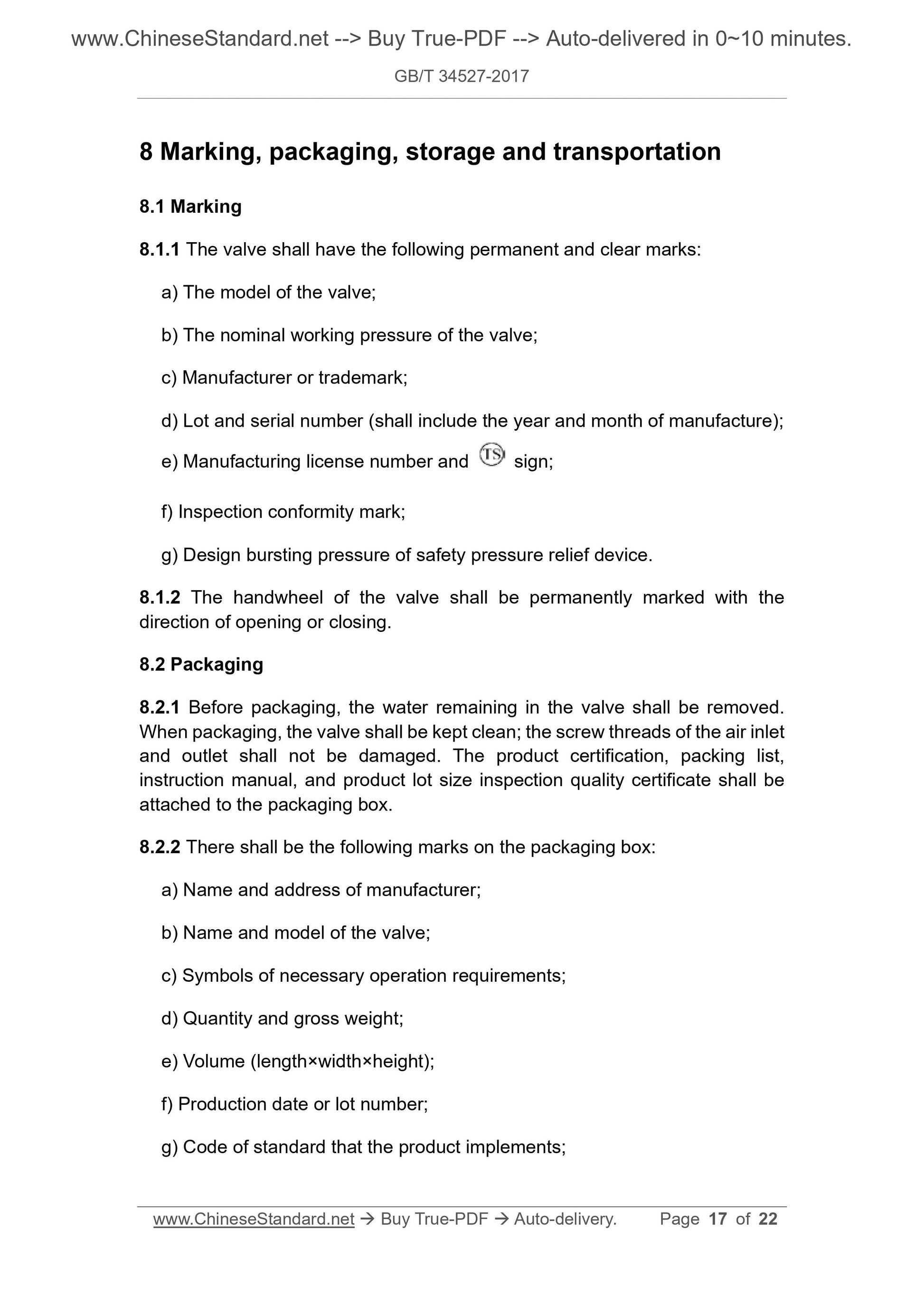1
/
von
8
PayPal, credit cards. Download editable-PDF and invoice in 1 second!
GB/T 34527-2017 English PDF (GBT34527-2017)
GB/T 34527-2017 English PDF (GBT34527-2017)
Normaler Preis
$210.00 USD
Normaler Preis
Verkaufspreis
$210.00 USD
Grundpreis
/
pro
Versand wird beim Checkout berechnet
Verfügbarkeit für Abholungen konnte nicht geladen werden
Delivery: 3 seconds. Download true-PDF + Invoice.
Get QUOTATION in 1-minute: Click GB/T 34527-2017
Historical versions: GB/T 34527-2017
Preview True-PDF (Reload/Scroll if blank)
GB/T 34527-2017: Specification of gas cylinder valve for air rebreather
GB/T 34527-2017
NATIONAL STANDARD OF THE
PEOPLE’S REPUBLIC OF CHINA
ICS 23.020.30
J 74
Specification of gas cylinder valve for air rebreather
ISSUED ON: OCTOBER 14, 2017
IMPLEMENTED ON: MAY 01, 2018
Issued by: General Administration of Quality Supervision, Inspection and
Quarantine of the PRC;
Standardization Administration of the PRC.
Table of Contents
Foreword ... 3
1 Scope ... 4
2 Normative references ... 4
3 Terms and definitions ... 5
4 Basic structural style and model ... 5
5 Technical requirements ... 7
6 Test methods ... 10
7 Inspection rules ... 14
8 Marking, packaging, storage and transportation ... 17
Appendix A (Informative) Connection type and dimension of valve inlet and
outlet ... 20
Appendix B (Normative) Mechanical impact resistance test device ... 22
Specification of gas cylinder valve for air rebreather
1 Scope
This Standard specifies the terms and definitions, basic structural style and
model, technical requirements, test methods, inspection rules, marking,
packaging, transportation, and storage of gas cylinder valve for air rebreather
(hereinafter referred to as "valve").
This Standard applies to cylinder valves used on air rebreathers with an
ambient temperature of -40 °C~+ 60 °C and a nominal working pressure of not
greater than 30 MPa.
This Standard does not apply to cylinder valves for rebreathers for medical and
diving use.
2 Normative references
The following documents are indispensable for the application of this document.
For the dated references, only the editions with the dates indicated are
applicable to this document. For the undated references, the latest edition
(including all the amendments) are applicable to this document.
GB/T 196 General purpose metric screw threads - Basic dimensions
GB/T 197 General purpose metric screw threads - Tolerances
GB/T 228.1 Metallic materials - Tensile testing - Part 1: Method of test at
room temperature
GB/T 1804 General tolerances - Tolerances for linear and angular
dimensions without individual tolerance indications
GB/T 3934 Specification of gauges for general purpose screw threads
GB/T 4423 Copper and copper-alloy cold-drawn rod and bar
GB/T 5121.1 Methods for chemical analysis of copper and copper alloys -
Part 1: Determination of copper content
GB/T 5121.3 Methods for chemical analysis of copper and copper alloys -
Part 3: Determination of lead content
b) The rubber seals shall be placed in oxygen at a pressure of 2.3 MPa±0.2
MPa, a temperature of 70 °C±5 °C, and a purity of ≥99.5% for 96 h for hot
air accelerated aging and heat resistance test. After the test, there shall
be no cracking.
c) The rubber seals shall be placed in the air at a temperature of -40 °C±2 °C
for 24 h for low-temperature test. After the test, there shall be no cracks
or other damage.
5.2 Process requirements
5.2.1 The valve body shall be forged and formed. On the surface of the valve
body, there shall be no defects such as cracks, wrinkles, inclusions, looseness,
shrinkage, underfill which would impair the performance of the valve.
5.2.2 The valve body and components without individual tolerance indications
are processed according to level M in GB/T 1804 standard.
5.2.3 Before leaving the factory, the valve shall be kept clean; there shall be no
oil stains and visible foreign particles.
5.3 Performance requirements
5.3.1 Opening and closing
The opening and closing of the valve shall meet the following requirements:
a) Under the nominal working pressure, if the handwheel diameter is ≥65
mm, the opening and closing torque of the valve shall not be greater than
7 N • m. If the handwheel diameter D is < 65 mm, the opening and closing
torque shall not be greater than 7D/65 N • m;
b) The valve shall be subjected to a resistance torque test of the operating
mechanism. USE a torque of 25 N • m to close the valve. The operating
mechanism shall be free of breakage; and, it is able to open the valve.
Then, continue to increase the torque, until the valve's operating
mechanism fails. The pressure holding element shall not be damaged.
5.3.2 Air tightness
The air tightness of the valve shall meet the following requirements:
a) At 1.2 times the nominal working pressure, the valve is closed and open
arbitrarily. There shall be no leakage for at least 1 min of pressure holding;
b) Under the pressure of 0.05 MPa, the valve is closed and opened arbitrarily.
There shall be no leakage for at least 1 min of pressure holding.
The operating mechanism of the valve shall generally be equipped with a
locking device in the open state. If the valve cannot be locked after the valve is
opened, the handwheel in the full-open state shall be rotated at least two turns
to close the valve.
5.3.10 Unscrewing torque of pressure cap
The unscrewing torque of the pressure cap of the valve shall not be less than
50 N • m.
5.3.11 Stress corrosion resistance of valve body
After 4 h of ammonia test in an ammonia water container with a temperature of
25 °C±1 °C, the valve body shall have no visible cracks.
6 Test methods
6.1 General test rules
6.1.1 Test environment
Except for special requirements, the tests of this Standard are carried out at
room temperature 15 °C~30 °C. The test room shall be kept shockproof,
dampproof, corrosion proof, and ventilated.
6.1.2 Test medium
Except that the pressure resistance test medium is clean tap water, the medium
for other tests is pure dry air or nitrogen.
6.1.3 Pressure gauge for tests
The accuracy of the pressure gauge for tests shall not be lower than level 1.6.
The range of the pressure gauge shall be 1.5~2 times the test pressure.
6.2 Material inspection
6.2.1 Mechanical properties test and chemical composition analysis
method of valve body metal materials
The tensile test samples and test methods of the valve body metal materials
shall be implemented in accordance with GB/T 228.1. The chemical
composition analysis methods shall be implemented in accordance with the
standards such as GB/T 5121.1, GB/T 5121.3, GB/T 5121.9, YS/T 482. If other
materials are used, the chemical composition analysis method shall be in
accordance with the corresponding standard.
close the valve. From the air inlet of the valve, fill nitrogen or air to 1.2 times the
nominal working pressure. Immerse the test device in water to hold pressure at
least 1 min. The result shall meet the requirements of 5.3.2 a).
6.6.2 Opening air tightness test
Install the valve on the test device. BLOCK the air outlet. According to the torque
specified in 5.3.1 a), open the valve to any open state. From the air inlet of the
valve, fill nitrogen or air to 1.2 times the nominal working pressure. Immerse the
test device in water to hold pressure at least 1 min. REPEAT opening and
closing valve. The result shall meet the requirements of 5.3.2 a).
6.6.3 Low-pressure air tightness test
Install the valve on the test device. From the air inlet of the valve, fill nitrogen or
air at a pressure of 0.05 MPa; TEST according to the methods of 6.6.1 and
6.6.2. The result shall meet the requirements of 5.3.2 b).
6.7 Vibration resistance test
Install the valve on the test device. According to the torque specified in 5.3.1 a),
close the valve. From the air inlet of the valve, fill nitrogen or air to the nominal
working pressure. Then, install the test device on the vibration test bench.
According to th...
Get QUOTATION in 1-minute: Click GB/T 34527-2017
Historical versions: GB/T 34527-2017
Preview True-PDF (Reload/Scroll if blank)
GB/T 34527-2017: Specification of gas cylinder valve for air rebreather
GB/T 34527-2017
NATIONAL STANDARD OF THE
PEOPLE’S REPUBLIC OF CHINA
ICS 23.020.30
J 74
Specification of gas cylinder valve for air rebreather
ISSUED ON: OCTOBER 14, 2017
IMPLEMENTED ON: MAY 01, 2018
Issued by: General Administration of Quality Supervision, Inspection and
Quarantine of the PRC;
Standardization Administration of the PRC.
Table of Contents
Foreword ... 3
1 Scope ... 4
2 Normative references ... 4
3 Terms and definitions ... 5
4 Basic structural style and model ... 5
5 Technical requirements ... 7
6 Test methods ... 10
7 Inspection rules ... 14
8 Marking, packaging, storage and transportation ... 17
Appendix A (Informative) Connection type and dimension of valve inlet and
outlet ... 20
Appendix B (Normative) Mechanical impact resistance test device ... 22
Specification of gas cylinder valve for air rebreather
1 Scope
This Standard specifies the terms and definitions, basic structural style and
model, technical requirements, test methods, inspection rules, marking,
packaging, transportation, and storage of gas cylinder valve for air rebreather
(hereinafter referred to as "valve").
This Standard applies to cylinder valves used on air rebreathers with an
ambient temperature of -40 °C~+ 60 °C and a nominal working pressure of not
greater than 30 MPa.
This Standard does not apply to cylinder valves for rebreathers for medical and
diving use.
2 Normative references
The following documents are indispensable for the application of this document.
For the dated references, only the editions with the dates indicated are
applicable to this document. For the undated references, the latest edition
(including all the amendments) are applicable to this document.
GB/T 196 General purpose metric screw threads - Basic dimensions
GB/T 197 General purpose metric screw threads - Tolerances
GB/T 228.1 Metallic materials - Tensile testing - Part 1: Method of test at
room temperature
GB/T 1804 General tolerances - Tolerances for linear and angular
dimensions without individual tolerance indications
GB/T 3934 Specification of gauges for general purpose screw threads
GB/T 4423 Copper and copper-alloy cold-drawn rod and bar
GB/T 5121.1 Methods for chemical analysis of copper and copper alloys -
Part 1: Determination of copper content
GB/T 5121.3 Methods for chemical analysis of copper and copper alloys -
Part 3: Determination of lead content
b) The rubber seals shall be placed in oxygen at a pressure of 2.3 MPa±0.2
MPa, a temperature of 70 °C±5 °C, and a purity of ≥99.5% for 96 h for hot
air accelerated aging and heat resistance test. After the test, there shall
be no cracking.
c) The rubber seals shall be placed in the air at a temperature of -40 °C±2 °C
for 24 h for low-temperature test. After the test, there shall be no cracks
or other damage.
5.2 Process requirements
5.2.1 The valve body shall be forged and formed. On the surface of the valve
body, there shall be no defects such as cracks, wrinkles, inclusions, looseness,
shrinkage, underfill which would impair the performance of the valve.
5.2.2 The valve body and components without individual tolerance indications
are processed according to level M in GB/T 1804 standard.
5.2.3 Before leaving the factory, the valve shall be kept clean; there shall be no
oil stains and visible foreign particles.
5.3 Performance requirements
5.3.1 Opening and closing
The opening and closing of the valve shall meet the following requirements:
a) Under the nominal working pressure, if the handwheel diameter is ≥65
mm, the opening and closing torque of the valve shall not be greater than
7 N • m. If the handwheel diameter D is < 65 mm, the opening and closing
torque shall not be greater than 7D/65 N • m;
b) The valve shall be subjected to a resistance torque test of the operating
mechanism. USE a torque of 25 N • m to close the valve. The operating
mechanism shall be free of breakage; and, it is able to open the valve.
Then, continue to increase the torque, until the valve's operating
mechanism fails. The pressure holding element shall not be damaged.
5.3.2 Air tightness
The air tightness of the valve shall meet the following requirements:
a) At 1.2 times the nominal working pressure, the valve is closed and open
arbitrarily. There shall be no leakage for at least 1 min of pressure holding;
b) Under the pressure of 0.05 MPa, the valve is closed and opened arbitrarily.
There shall be no leakage for at least 1 min of pressure holding.
The operating mechanism of the valve shall generally be equipped with a
locking device in the open state. If the valve cannot be locked after the valve is
opened, the handwheel in the full-open state shall be rotated at least two turns
to close the valve.
5.3.10 Unscrewing torque of pressure cap
The unscrewing torque of the pressure cap of the valve shall not be less than
50 N • m.
5.3.11 Stress corrosion resistance of valve body
After 4 h of ammonia test in an ammonia water container with a temperature of
25 °C±1 °C, the valve body shall have no visible cracks.
6 Test methods
6.1 General test rules
6.1.1 Test environment
Except for special requirements, the tests of this Standard are carried out at
room temperature 15 °C~30 °C. The test room shall be kept shockproof,
dampproof, corrosion proof, and ventilated.
6.1.2 Test medium
Except that the pressure resistance test medium is clean tap water, the medium
for other tests is pure dry air or nitrogen.
6.1.3 Pressure gauge for tests
The accuracy of the pressure gauge for tests shall not be lower than level 1.6.
The range of the pressure gauge shall be 1.5~2 times the test pressure.
6.2 Material inspection
6.2.1 Mechanical properties test and chemical composition analysis
method of valve body metal materials
The tensile test samples and test methods of the valve body metal materials
shall be implemented in accordance with GB/T 228.1. The chemical
composition analysis methods shall be implemented in accordance with the
standards such as GB/T 5121.1, GB/T 5121.3, GB/T 5121.9, YS/T 482. If other
materials are used, the chemical composition analysis method shall be in
accordance with the corresponding standard.
close the valve. From the air inlet of the valve, fill nitrogen or air to 1.2 times the
nominal working pressure. Immerse the test device in water to hold pressure at
least 1 min. The result shall meet the requirements of 5.3.2 a).
6.6.2 Opening air tightness test
Install the valve on the test device. BLOCK the air outlet. According to the torque
specified in 5.3.1 a), open the valve to any open state. From the air inlet of the
valve, fill nitrogen or air to 1.2 times the nominal working pressure. Immerse the
test device in water to hold pressure at least 1 min. REPEAT opening and
closing valve. The result shall meet the requirements of 5.3.2 a).
6.6.3 Low-pressure air tightness test
Install the valve on the test device. From the air inlet of the valve, fill nitrogen or
air at a pressure of 0.05 MPa; TEST according to the methods of 6.6.1 and
6.6.2. The result shall meet the requirements of 5.3.2 b).
6.7 Vibration resistance test
Install the valve on the test device. According to the torque specified in 5.3.1 a),
close the valve. From the air inlet of the valve, fill nitrogen or air to the nominal
working pressure. Then, install the test device on the vibration test bench.
According to th...
Share
